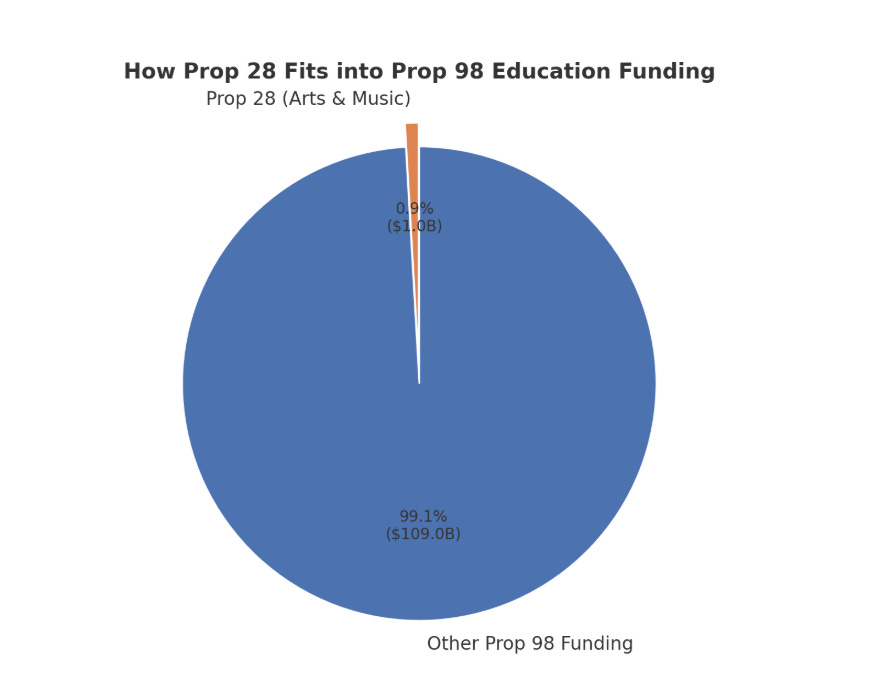Passed in 2022, Proposition 28 requires California to dedicate a portion of the Prop 98 education guarantee specifically for arts and music education. Unlike facilities bonds (Prop 51 in 2016 or Prop 2 in 2024) or broad funding guarantees (Prop 98), Prop 28 is program-specific, ensuring every student has access to creative learning opportunities, regardless of zip code or family income.
What It Does
Sets aside about 1% of the state’s K–12 education budge, roughly $1 billion annually and for arts and music programs.
Requires at least 80% of funds to go toward staffing (teachers, teaching artists, program specialists).
Allows up to 20% for supplies and resources (instruments, art materials, software, field trips).
Allocates additional funds to schools serving more low-income students, English learners, and foster youth.
Requires that 90% of funds be spent at the school site, with up to 1% for district administration.
Who Benefits
All K–12 public schools receive funding, but high-need schools receive more per student to help close opportunity gaps.
Example: A Los Angeles Unified school serving many low-income students will get more per pupil than a wealthier district like Palo Alto Unified.
Funding must be used for arts and music programs—schools cannot redirect it to general budgets or unrelated programs.
Why Voters Supported Proposition 28
California voters approved Prop 28 for several reasons:
Equity and Access – Ensures all students, especially in low-income or under-resourced schools, have guaranteed arts and music opportunities.
Student Engagement and Achievement – Arts programs improve motivation, attendance, and academic performance while supporting social-emotional development.
Whole-Child Education – Provides balance to testing-focused curricula, signaling that creativity and expression matter alongside core academics.
Job Creation – Funds hiring of arts teachers, teaching artists, and program specialists.
Fiscal Appeal – Does not raise taxes; the funding comes from 1% of the existing Prop 98 K–12 budget, making it politically and economically accessible.
Broad Support – Endorsed by teachers’ unions, arts organizations, parent groups, and public figures.
Pros
Guarantees every student access to arts and music programs.
Creates stable, predictable funding each year.
Supports equity-focused staffing in high-need schools.
Expands job opportunities for arts educators and teaching artists.
Boosts student engagement, creativity, and well-being.
Cons
Does not bring in new revenue; funds come from the existing Prop 98 budget.
Reduces district flexibility, especially in schools already facing deficits.
Some districts may need to adjust staffing or cut other positions to meet the 80% staffing requirement.
Teacher shortages may make it difficult to hire qualified arts staff.
Educator’s Perspective
For teachers, Prop 28 can mean a dedicated art or music teacher where there was none before. At the same time, districts with tight budgets may need to make trade-offs, potentially affecting aides, intervention teachers, or counselors. Prop 28 guarantees arts and music access, but it doesn’t solve broader funding challenges in literacy, STEM, or mental health.
Follow up Questions:
How do we make sure guaranteed arts funding doesn’t come at the expense of other critical supports like literacy intervention, STEM, or counseling—especially when some districts just last year were laying off classroom teachers and increasing class sizes?
What’s the best way to measure the real impact of Prop 28—are we looking at creativity and engagement, or more traditional outcomes like attendance and achievement?
With teacher shortages already a challenge, how can schools realistically meet the 80% staffing requirement without stretching themselves too thin?


